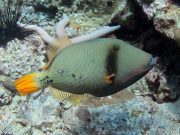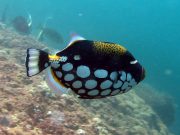Diving with Triggerfishes
Lanta Marine Life | Balistidae
There are around 40 species of triggerfish, with many species finding a home at the dive sites around Koh Lanta.
All family members have a flattened oval shaped body, with a large head, small mouth, and eyeballs that are capable of rotating independently of each other. The body is protected by thick, tough skin, covered in large scales.
Many species have brightly coloured bodies, patterned with lines and spots, and can range in size from just a few centimeters to over a meter in length. Around Koh Lanta, we rarely see triggerfish greater than 50 cm in length.
Triggerfish are well known for their two dorsal fins, the first (forward) of which has 3 visible spines that can be raised as a warning sign (trigger) to potential predators or divers.
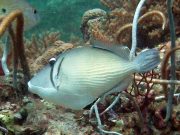
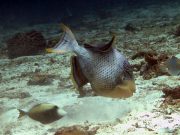
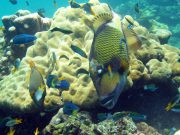
The first spine of the forward dorsal fin is more than double the length of the second spine, with the second spine being used to lock the first spine into an upright position.
Triggerfish feed on coral, sea urchins, crustaceans and snails, using their 8 very strong outer teeth to crush shells, urchins, and branching coral.
Larger triggerfish are often seen turning over rocks, stirring up the sand with their fins, and blasting away debris with water jets squirted from their mouths.
This vigorous feeding activity creates a lot of disturbance on the reef, digging up many small worms, crustaceans, and molluscs, and attracting many smaller fish who feed on the leftovers.
Triggerfish are usually seen solitary, but form pairs for mating, with males preparing nests on the seafloor and protecting the eggs from potential predators, including divers.
Both males and females care for the eggs, which resemble a lump of pinkish jelly-like substance, often squirting water over the eggs to keep them oxygenated.
If you stray into a triggerfish nesting area, don't be surprised to find yourself being charged by a very defensive and angry triggerfish, possibly receiving a nasty bite from the large front teeth.
Titan triggerfish are by far the most aggressive and their nests should never be approached.
9 species found on this page:
- Blue Triggerfish (Pseudobalistes fuscus)
- Yellowmargin Triggerfish (Pseudobalistes flavimarginatus)
- Clown Triggerfish (Balistoides conspicillum)
- Titan Triggerfish (Balistoides viridescens)
- Indian Triggerfish (Melichthys indicus)
- Red Tooth Triggerfish (Odonus niger)
- Scythe Triggerfish (Sufflamen bursa)
- Flagtail Triggerfish (Sufflamen chrysopterus)
- Orange-lined Triggerfish (Balistapus undulatus)
Blue Triggerfish
(Pseudobalistes fuscus)
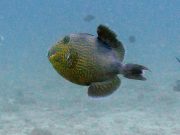
Large Juvenile Pseudobalistes fuscus @ Koh Haa
Adult Blue Triggerfish are bluish grey and usually have yellowish spots on their scales. All the fins have pale blue to yellow to muddy red margins.
Juvenile Blue Triggerfish have a yellowish-orange body with many bright blue horizontal wavy lines and spots on the body, continuing onto the dorsal, anal and tail fins. There are bright blue lines radiating from the eyes.
The Blue Triggerfish grows to 55 cm. Nesting females can be aggressive and may attack divers. The diet includes sea urchins, crustaceans, mollusks, fish and corals.
Yellowmargin Triggerfish
(Pseudobalistes flavimarginatus)
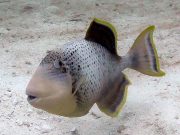
Pseudobalistes flavimarginatus @ Koh Haa
The Yellowmargin Triggerfish has a pale greyish-tan to greenish-tan body and pale pinkish-orangish face. The body is covered with dark spots and cross-hatch patterns. All the fins have yellow or slightly orangish outer margins.
The Yellowmargin Triggerfish grows to 60 cm and is one of the larger triggerfishes we see at the dive sites around Koh Lanta. This species can be aggressive when nesting and is found over sandy or rubble areas close to the reef edge. The diet includes the tips of Acropora coral branches, snails, shrimp, and sea urchins.
Clown Triggerfish
(Balistoides conspicillum)
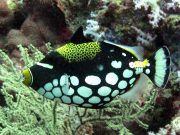
Balistoides conspicillum @ Koh Bida
The Clown Triggerfish has a black body with large white spots on the lower body and white behind the chin. The lips are orange and there is a white to yellow coloured band across the top of the snout. On the back is a yellow patch dark spots. The tail is balack and white.
The Clown Triggerfish is a solitary species, growing to 50 cm, but more usually observed 20 cm - 25 cm. The diet includes sea urchins, crabs and other crustaceans.
Titan Triggerfish
(Balistoides viridescens)
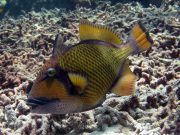
Balistoides viridescens @ Koh Haa
Titan triggerfish are the largest species of triggerfish, growing to 80cm in length. The body is green and yellow with a white lower jaw and tail base. They have dark markings above the mouth which look like a moustache and black edgings on their fins and around their eyes.
Apart from sharks and Giant Grouper, not much is known about what in particular preys on mature titan triggerfish. Their size and strength don't make them an easy meal.
Titan triggerfish spawn with the lunar cycles and tides. The males will establish territories and build open nests on sandy bottoms or reefs. He will have 2 or 3 females joining him and he will mate with all of them. The eggs are laid within the nest and are cared for by both parents until hatching.
When they are tending to their eggs, a female titan triggerfish will guard her nests vigorously against all intruders. Their territory around the nest is cone shaped towards the surface and divers who accidentally enter it may be chased away. Divers should swim horizontally away from the nest rather than upwards which would only take them further into the territory. Although bites are not venomous, they and can inflict an injury that may require medical attention, so it is best to be wary and observe from a distance when they are nesting.
Indian Triggerfish
(Melichthys indicus)
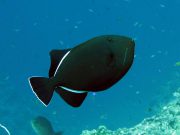
Melichthys indicus @ Koh Haa
The Indian Triggerfish, also known as the Blackfin Triggerfish, has a dark grey to brown to almost black body, with jet-black fins.
There is a white band at the base of the second dorsal fin, the base of the anal fin, and on the tail fin margin.
There is often a variably coloured diagonal streak on the lower face, starting behind the mouth, along the cheek / chin line.
The Indian Triggerfish grows to 25 cm and feeds on algae, crustaceans, small invertebrates and sponges.
Red Tooth Triggerfish
(Odonus niger)

Odonus niger @ Hin Muang
The Red Tooth Triggerfish has a pale blue head and a dark blue to blue-purple body. There are 2 bluish-green lines from the eye to the end of the mouth. The tail is crescent-shaped, with long fin lobes and the fins generally have pale margins. The teeth are reddish.
The Red Tooth Triggerfish grows to 40 cm, but more usually observed around 8 cm - 15 cm. This species forms small groups around dive sites such as Koh Haa or Koh Bida, and very large, but loose groups around Hin Muang. Feeds on plankton.
Scythe Triggerfish
(Sufflamen bursa)
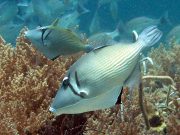
Sufflamen bursa @ Hin Bida
The Scythe Triggerfish can quickly vary the body colour from light grey to dark brown. Some, or all of the face, chin and belly may be white.
There is a yellow-orange or dark brown scythe-shaped marking behind the eye and through the pectoral fin base.
The rear edge of the pelvic flap is black.
The Scythe Triggerfish grows to 25 cm and the diets includes crabs, shellfish, snails, algae, worms and other reef bottom-dwellers.
Flagtail Triggerfish
(Sufflamen chrysopterus)
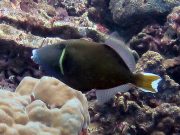
Sufflamen chrysopterus @ Koh Haa
The Flagtail Triggerfish can vary its body colour from dark brown to yellowish-brown. The chin and neck area are bluish.
There is a narrow yellow-orange or black bar from under the eye to past the pectoral fin base. The tail is yellow-brown with a strong white margin.
The Flagtail Triggerfish is a small triggerfish, growing to 30 cm, but more often observed around 15 cm - 20 cm.
This species is territorial and forms pairs, with the male defending the outer territory while the female directly guards the nest.
Orange-lined Triggerfish
(Balistapus undulatus)
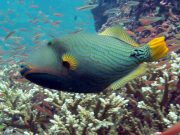
Balistapus undulatus @ Koh Haa
The Orange-lined Triggerfish has a green body with many diagonally curved orange stripes and a large dark spot on the tail base. There are a series of orange streaks from the mouth along the cheeks.
The second dorsal fin, pectoral fin, anal fin and tail fis are all yellow.
The Orange-lined Triggerfish grows to 30 cm, however more usually observed around 15 cm - 20 cm. The diet includes coral polyps, algae, sponges, worms, crabs, urchins and fishes. Usually seen solitary around coral rich areas.
Diving with Triggerfishes around Koh Lanta
Scuba Diving & Snorkel Trips
If you'd love a chance to spot Triggerfishes on one of our daily high season diving trips from Koh Lanta then send us an email to info@diveandrelax.com.
Join our high season speedboat dive trips to some of Thailand's best dive sites and enjoy small groups, short journey times, with a focus on great personal service, safety and fun.
Not yet a certified diver? Learn to Scuba Dive on Koh Lanta with the 3 day SSI Open Water Diver course.
Book online to save 10% on dive trips and scuba courses on Koh Lanta.
Find Out More
Indo-Pacific Marine Life Guides
- Allen, G., Steene, R., Humann, P., DeLoach, N. (2003) Reef Fish Identification, Tropical Pacific. Jacksonville, FL., USA: New World Publications, Inc., ISBN 1-878348-36-1.
- Humann, P., DeLoach, N., (2010) Reef Creature Identification, Tropical Pacific. Jacksonville, FL., USA: New World Publications Inc., ISBN 978-1-878348-44-9
- Debelius, H. (2013) Indian Ocean Reef Guide. Frankfurt, Germany: IKAN - Unterwasserarchiv, ISBN 978-3-939767-52-7.
- Debelius, H. (2004) Nudibranchs and Sea Snails, Indo-Pacific Field Guide. Frankfurt, Germany: IKAN - Unterwasserarchiv, ISBN 3-925919-51-1
- Erhardt, H., Knop, D. (2015) Corals Indo-Pacific Field Guide. Frankfurt, Germany: IKAN - Unterwasserarchiv, ISBN 3-925919-69-4.
- Veron J.E.N., Stafford-Smith M.G., Turak E. and DeVantier L.M. (2016). Corals of the World

